The big news is that the drought is officially over. In fact, we’re
currently running a rainfall surplus here in East Tennessee. This has not
only brought our stream levels back to normal, but also has implications for
fly fishing on the tailwaters.
Smoky Mountain Streams
Spring hatches started strong with Quill Gordon mayflies in the Smokies and
midges on the Holston, so the fishing was excellent. We’ve covered a lot of
water in the past three months. In the Smokies we’ve covered nearly every
inch of Little River from the Three Forks in the backcountry to the Townsend
Y. Greenbrier has fished well along with the West Prong of the Little Pigeon
River from the Sugarlands to the Chimneys.
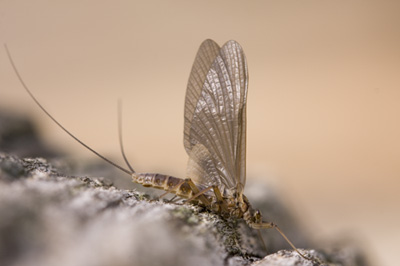
Quill Gordon photographed by Julie Tallman on a North Carolina stream
Brook trout fishing started a little slow since we had a cool spring, but
that has come along nicely everywhere from Sam’s Creek to Road Prong.
Some of our best days have been on the Carolina side of the park. Our Hazel
Creek Creek camp was the best we’ve ever done. The weather was fantastic and
water levels were great. Dry fly fishing was a little slower than we
expected, but the nymph fishing was superb.
The Oconaluftee system has also fished well. We’ve seen some excellent dry
fly fishing on the the ‘Luftee as well as Bradley Fork.
Tailwater Rivers
Water levels were tough on many of the tailwaters this spring, but we didn’t
notice because the Holston was in such great shape. Fortunately our home
tailwater fished well and we didn’t realize most other rivers in the region
were blown out.
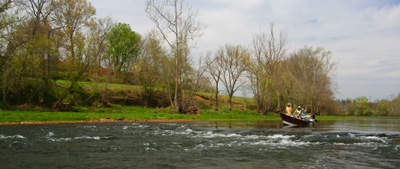
The Holston River was our primary float this spring
Recently our biggest problem has been trying to choose between the Clinch
and the Holston. Many anglers remember the glory days of the Clinch when
trout were abundant and big fish were common. We’re confident that those
days are back!
Trout have been everywhere in the Clinch since last fall. Most fish are in
the 9″-12″ range, but we’re hooking up good numbers of 14″-16″ trout as
well. We’ve even seen some good Sulphur hatches with rising trout. Perhaps
one of the most memorable moments of the season was when we saw a 18″ brown
trout’s tonsils as he slowly rose to a dry on the Clinch. Unfortunately that
fish broke off on the second jump, but what a sight!
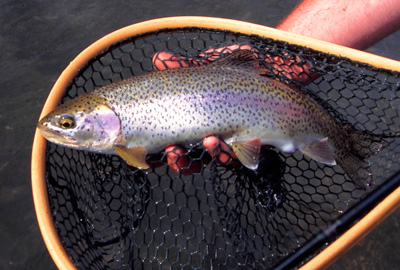
Fish like this are starting to show up regularly on the Clinch once again
Summer Fly Fishing Forecast
Mountain Streams
We seem to have a good pattern of afternoon thunderstorms in the mountains
right now and long range forecasts seem to show us in a “normal” summer
weather pattern. Normal summer weather in the Smokies includes pop up
thunderstorms. This is the best weather to have in June, July, and August as
the stream levels should remain quite good. Be sure to keep a light rain
jacket handy.
This is the time year when we begin to frequent brook trout streams. Most of
these require some kind of hike, but the resulting solitude is worth it.
Keep a fly box full of #14 Parachute Adams, Stimulators, and Thunderheads.
They’re always a hit with the specks.

Head to the higher elevations in the Smokies for colorful specks
Lower elevation streams like Little River and Abrams Creek should fish
better this summer than they have in several years. Nymphs fished riffles
and pockets should produce quite well, but don’t neglect terrestrial
patterns. The Elkmont Ant is our favorite terrestrial but inch worm patterns
are a favorite with many local anglers.

Tailwaters
The increased rainfall may make favorable tailwater flows a bit tougher to
come by over the summer. All of TVA’s reservoirs are full or even slightly more than full. With the long term forecast pointing to a normal, wet season TVA will have to generate to keep the lakes from getting too high. The hot summer months are also the time when power generation from area dams is crucial to meet the power demands caused by all of our air conditioning units.
Wading anglers will certainly have to keep a close eye on the schedules, but the Clinch and Watauga Rivers both have scheduling that anglers can rely on. The Clinch has a “recreational” schedule on weekends that considers fishermen.
Those fishing from boats will have more opportunities. The Clinch is often fishable from a boat when it can’t be waded. The South Holston should also have some excellent float schedules over the summer. The Hiwassee is best fished from a boat in the summer, but only those with experience on the river should attempt to row it in a drift boat. Personal pontoons can provide some excellent access to wadeable spots on this swift river.
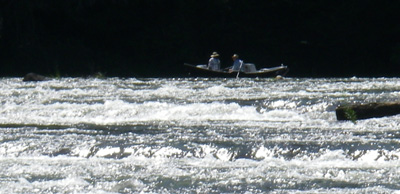
Only experienced oarsmen should attempt to float the Hiwassee
Smallmouth Bass
River smallies are the forgotten gamefish in the Southeast. Most river fishermen chase trout and the average bass fisherman heads to an area lake, so smallmouth bass in rivers and streams are rarely fished. This is a huge mistake in our opinion since East Tennessee has some of the finest smallmouth rivers and streams in the country.
Many fly fishers live closer to the fish than they do trout. Even better, they are often active in the hottest months when the action on many trout streams slows down.
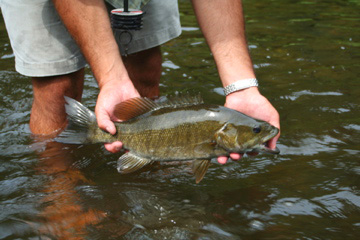
This Pigeon River smallmouth ate a popper and put up a spectacular fight.
The Pigeon and Nolichucky Rivers in East Tennessee are both standouts with good access, excellent fishing, and plenty of opportunities for wading or floating. The Tuckaseegee, Little Tennessee, and French Broad in Western North Carolina also provide superb opportunities for these hard fighting game fish.
You probably already have the gear you need to fish for smallmouth in rivers and streams. While a 6 or 7 weight fly rod is ideal, you can easily get on some fish with a 5 weight. Poppers are our favorite, but streamers also attract bass.

Bill Henegar says
Ian: Just wanted to tell about the trip Drew,Blake, and myself had this spring. We still talk about catching over 100 rainbow, (1) smallmouth, plus a lot of good fun. It was hard to believe they averaged 7-10″.
I am just recovering from shoulder “fatigue.”
Hope to see you soon.
Bill Henegar
Ian says
That was a great day on the river! We’re always thrilled when we can put people on so many fish in a day.